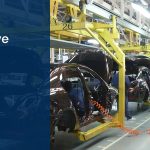Table of Contents
Automotive Industry Trends in 2023
The economy today is dramatically changing with the development in upcoming markets, a quick rise in new technologies, changing consumer preferences and sustainability policies. Digital giants like Amazon and Netflix are examples of setting exceptional standards for a better customer experience.
Customers have the same expectation for automobiles. Digitization, automation, and newer business models have revolutionized the automotive industry as well. The newcomers in the market are thriving because of their technology and design that satisfy the customer.
In this article, we’ll look at the top 12 automotive trends today.
What Are The Challenges Facing The Automotive Industry?
2020 has been a disruptive year. While it’s been tough for everyone around the world, the automotive industry faced particular challenges.
COVID hasn’t fundamentally made a change in trajectory for automotive retail and manufacturing. The industry was already at a crossroads and social distancing has accelerated the changes that were already taking shape.
We’ll look at the main challenges the automotive industry is facing today:
Online Sales
Things get complicated for brands as in how online sales have affected the traditional structures. Customers don’t immediately buy online, they engage with multi-channel purchasing, visiting dealers, researching online, and making a purchase from different touchpoints.
Remote Working
During the pandemic, many networks shut down while others switched to remote working. Managing remote employees while maintaining quality control is a challenge for automotive sales. It’s never easy closing dealerships, and this has made it even harder with online sales.
New Technology & Concepts of Ownership
Many car dealers are trying to understand how shared mobility and autonomous vehicle inventions will impact automotive businesses. Technology enthusiasts are leading the revolution. This will force dealerships to restructure businesses and take advantage of this technology change. Some experts say vehicle sales will dip, while some remain optimistic. They believe reinventing their businesses will help discover new opportunities and increased revenue.
Shortage of Semiconductors
One of the serious problems for automakers recently has been the shortage of semiconductors. These are becoming a very important element for vehicles. With semiconductor suppliers, there is relatively little clout, accounting just for 2% – 3% total demand. The lack of supply resulted in automotive production lines shutting down, even when consumer demands had increased.
12 Key Trends In The Automotive Industry In 2023
The automotive industry is growing at an exhilarating pace. Advanced technologies and people changing their ways of transport are forcing the industry to adapt existing skills, integrate AI and adopt new processes.
Gradually, the auto industry is thinking futuristically, where they will generate more revenue. And the future of automobiles is ‘EASCY’ which means electrified, autonomous, shared, connected, and yearly updated.
Here are the top 12 trends in the automotive industry in 2023:
1. Electrification
Electric vehicles are addressing challenges like fossil fuels and environmental damage by promoting the use of energy efficiently and reducing fuel usage. EVs will ensure emission-free mobility, which will become a global need.
Renewable sources of energy will be increasingly used to charge vehicles using electricity, ensuring carbon dioxide neutral mobility. Not dealing with hazardous materials in EVs can have a positive effect on economic and environmental performance.
Related Report: Global Electric Vehicle Market Analysis–Trends, Insights and Forecast (2020-2027)
2. Autonomous
Autonomous vehicles are self-driving vehicles, which need no human intervention. This minimizes the need for human drivers and can transform everyday transportation. AVs make public transportation safer, for example, they can reduce accidents mainly caused due to driver fatigue or negligence. They have advanced recognition technologies, such as AI enhanced computer vision, which identifies obstacles along the road.
The reduction in vehicle congestion will result in reducing CO2 emissions. AV technology improves fuel economy by its smooth accelerating and decelerating method compared to a human driver. A section of closely spaced vehicles, which stops and slows efficiently, enable lower peak speeds, which improves fuel economy, but high effective speeds (improves travel time).
3. Shared Mobility
Professionally managed shared vehicles will ensure significant cost reduction in mobility. New business models have started focusing on shared mobility instead of traditional vehicle ownership. This encourages mobility as a service and discourages vehicles from being used. Such solutions are valuable in the cities or companies, which ensure not adding more vehicles. This will reduce waiting time in traffic and pollution by vehicles.
Shared mobility decreases vehicle usage on road, which means CO2 emissions are significantly reduced, benefiting a pollution-free environment. Millions of vehicles in the city can carry half a million tons of CO2, which is emitted into the atmosphere.
4. Connectivity
This innovation can decrease traffic and severe accidents and sudden accidents or fatalities. The introduction of Vehicle to Vehicle (V2V) innovation helps vehicles receive a signal immediately from the other vehicles in the car route.
They also come with tamper-proof digital identities. This eases tracking of data for cases such as driver safety, insurance, maintenance, and fleet management. This not only helps the customer but transforms the mobility ecosystem.
5. Yearly Updates
An annual update for a range of models will ensure having the latest software and hardware developments. Also, they can monitor their health and book maintenance-related appointments. Yearly updates will also ensure safety and lesser emissions as emissions standards are expected to get stricter around the world.
6. Artificial Intelligence
AI technologies like machine learning, deep learning, and computer vision are one of the most important trends of the industry. AI guided autonomous cars helps drivers in safety, managing fleets, and enhances vehicle insurance and inspection services.
AI applications in manufacturing, production, and acceleration to bring down costs. Human Machine Interface (HMI) will manage and operate the vehicle using voice-based feedback.
AI uses various sensors for collision detection, blind-spot monitoring, lane monitoring, pedestrian detection, etc. which identifies dangerous scenarios and alerts the driver. With new technology being invented, you also get notified if there is an overload on the roof rack.
7. Blockchain
Blockchains has several applications in the automotive industry. They include sharing a vehicle’s data to a secure network to allow connectivity and mobility solutions like shared urban transportation, deliveries, and ride-hailing. It also has medical records, identity management, proving provenance, and financial transactions.
Additionally, it creates applications to verify the supply chain of raw materials and spare parts. Mainly, if they’re being sourced from trusted and legal sources. Blockchain has the potential of removing middlemen in the trade and transaction process.
8. AR/VR Solutions
They are made specifically to help newly joined employees. He industry can utilize an AR/VR model as a learning motive and give a virtual view to the customers. 3D printing also helps the automotive industry.
It allows quick prototyping, using the help of 3D models which accelerates the testing period and design. They enable manufacturers to print spare parts that match their requirements. The composite materials deliver lighter, durable, and sturdy automotive parts.
With progress in advanced technology, customers experience the characteristics of a vehicle’s behavior and push it to the limit. Another key aspect is self-servicing. If there are small malfunctions or no mechanics, AR can help users identify and take corrective measures to carry out repair and maintenance on their vehicles.
9. Smart Factory
The automotive sector is enthusiastic about smart factories. They are making large investments and setting higher targets for their manufacturing operations than any sector. A smart factory is a vital part of manufacturing cars in a fast, standardized, and error-free manner across the globe.
Robotic Process Automation (RPA) uses digitization, automation, and modeling to offer a flexible and stabilized manufacturing process. Apart from using robotics and automation for manufacturing, digital factories have advantages to develop a great business.
10. Cloud/Hybrid Computing Models
Computing and data have seen a massive demand within the automotive industry. A huge amount of collective innovation is being done. For example, in data pipelines, computing capacity, data capacity, AI, and analytics-based algorithms.
Automotive companies have started owning new computing requirements. They are only addressed with two computing model; cloud and hybrid, which give access to high-capacity demand due to computing and storage-intensive workloads. Car companies’ partner with them to bring out innovation the right way.
11. Digital Marketing
Online selling of automotive vehicles came to view during the coronavirus pandemic. Even though, in-person visits to dealership stores and test drives were mandatory before buying a car. The lockdown forced people to switch to the online medium.
Dealerships are switching to the idea of normalizing buying cars online by offering virtual tours, financial options, secure checkout, and return policies. Dealerships have made it an important task to communicate and take their marketing efforts online, so they can be at the forefront of a customer’s decision-making process.
12. Big Data & Data Analytics
With data analysis having increasingly better possibilities, predictive analytics has developed into a powerful tool, encouraging an enormous boost in operations performance and forecasting efficiency.
Advanced data analytics gives us an understanding of several decisions of that particular vehicle’s life cycle. Data collected from vehicles alert on predictive maintenance, emergencies, or accidents and notify managers on fleets. With predictive analysis, car manufacturers can make decisions on annual sale purchases and targets regarding production.
Automotive Industry Stats And Growth Projections
The automotive industry is vast and intensively advancing on a large scale. It is a leading market for global economic growth. Here are some statistics on the automotive industry.
- Global market – The market size of the Global Car and Automobile Manufacturing Industry, which is measured by revenue, is at $2.7 trillion in 2021.
- Worldwide sales – The worldwide market is expected to grow in car sales, which is just under 70 million in 2021.
- Asia Pacific – It’s been projected that the Asia Pacific, in the coming years, will lead in the highest automotive market revenue.
- Electric vehicles – Electric vehicles are set to grow in the automotive market in 2021, to a 6%-8% of the global share of the market.
- Light vehicle sales – Light vehicle sales are estimated to increase by around 9 percent in 2021. Despite the coronavirus pandemic in 2021, the automotive industry is expected to make sales, exceeding 83 million units.
- Big data market – The big data market was valued at $3,289.60 million in 2019, and by 2025, it’s expected to reach $7,884.01 million, registering a 16.81% CAGR during 2020-2025.
Summary
Additive manufacturing, AI-based automation, big data for design and production, and human-machine interfaces changing the manufacturing processes for the automotive industry. The demand for electric cars and self-driven cars is advancing with machine learning and the Internet of Things (IoT).
This also pushes new business models such as shared vehicles, analytics-driven maintenance, insurance, and safety improvements. Hybrid vehicles, automotive sensor technology, and robotics will transform the automotive industry sector.
Technology is a power that can transform any experience into a profiting experience. You can be prepared for even more eye-widening advances the automotive industry will offer.
Looking for Automotive Market Research Reports?
We hope you feel the thrill of the futuristic prospects of all these automotive industry trends in 2021.
Global Industry Reports Inc is a place of leading insights, research, and data expertise around the world. We give fair evaluations and opinions of market openings with detailed and precise market research reports. We take pride in loyalty, accuracy, and working spirit in our research reports.
If you need a custom automotive market research report, you can get in touch with us by filling out the contact form.






